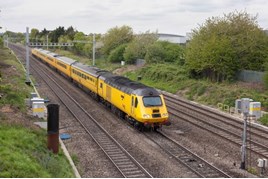Electrification in Scotland is a matter for the Scottish Government, as opposed to the Department for Transport in the rest of the UK, although the work will still be delivered by Network Rail. The £742 million Edinburgh-Glasgow Improvement Programme will mean that the main line between Glasgow and Edinburgh (via Linlithgow and from Cumbernauld towards Glasgow) will be electrified. Completion is expected by 2016.
NR has clearly begun in earnest a major programme of electrification on key routes across the UK railway network - which will mean faster, greener, quieter and more reliable journeys for thousands of passengers. It is supported in this by the Government, which has committed to investing in a programme of electrification to transform the railway and provide Britain with a sustainable transport system built to the highest standard.
National Electrification Programme Director Saleem Mohammad is as knowledgeable and passionate about electrification as you might expect. Clearly he’s an advocate of electrification, yet he’s refreshingly realistic about the current electrification programme now under way.
Just over a year ago, Network Rail awarded the major framework contracts. Successful bidders included ABC, Balfour and Carillion. These work specified in these contracts would enable the delivery of major electrification schemes on the Great Western Main Line, the Midland Main Line, and in the North West.
Mohammad’s team - the National Electrification Delivery Steering Group - sits at the top of a structure that is designed to make the most of electrification in the UK. The scale of the work to electrify during Control Period 5 has not been without its challenges, with the various groups working to ensure that the industry’s supply chain is working as efficiently as it can. These new electrified railways must be fit for purpose, although not, as Mohammad reminds us, “at any cost”.
It’s Mohammad’s job to ensure that sufficient resources, qualified people and integrated planning are in place - crucial elements for what lies ahead (and indeed, what has already started).
“The last time we did this level of work was 25 years ago,” he says, referring to the East Coast Main Line electrification between London and Edinburgh, which was completed in 1991.
“Since then, we have lost staff. And the plant got a bit rusty. Around £4bn is currently committed to electrification. Not only is that a significant step up, but HS2 is ramping up too,” says Mohammad. “We are relying on a number of resources. Regional programmes are using a lot of the same resources. The National Grid is also in quite a poor state.”
Mohammad and his colleagues must look at the national picture, and try to identify economies of scale wherever possible. With the need to essentially start again on a rolling programme of electrification, there is a need to ensure that lessons can be learnt from the current schemes - the knowledge must be gained in readiness for the 2019-2024 period. “We can’t predict what will happen in CP6” says Mohammad. “It’s about getting it right now, but also preparing for the future”.
The benefits of railway electrification haven’t always been widely recognised. After all, aside from one exception, the 1997-2010 Labour government did not sanction a single electrification scheme. While some civil servants at the Department for Transport may have been convinced that electrification is a good thing, it’s certainly not the case that ministers understood its value.
“There are a number of factors. Take a typical diesel train and replace it with a typical electric train. You get a 30-35% reduction in CO2 emissions” says Mohammad.
The industry’s preference is for modern passenger trains to have a traction package underneath the carriage - removing the need for an engine at the front allows for a 20% increase in passenger capacity. Electric traction packages allow for improved performance with faster acceleration and deceleration. On a typical commuter line - such as London-Paddington-Swansea, this allows trains to not only reach their destinations more quickly, but also be turned around more speedily at each end of the line. With the increased train paths available, more trains can run, and therefore capacity is increased.
The benefits to the wider economy are also felt. It’s possible that Britain’s power needs will not be met fully in the future, given the decline and gradual closure of the coal industry, and the delays in bringing new nuclear power on stream, let alone renewable energy. The National Grid may find itself struggling to meet demand.
The ‘smart grid’ puts more focus on power regeneration and using power more intelligently. When traction motors on electric trains run in reverse - i.e. when they are slowing down – they can generate energy, which can then be stored and used towards the next journey.














Login to comment
Comments
No comments have been made yet.